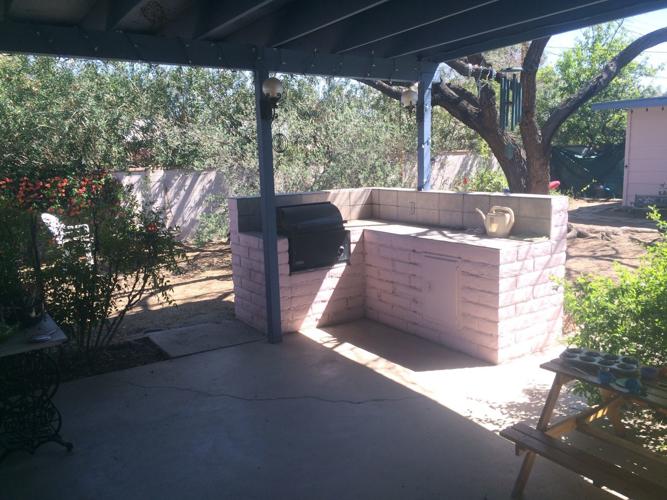If you’re eyeing your yard with re-landscaping in mind, Jason Isenberg has a suggestion on how to start.
Try not to get too emotionally attached to the way it looks now.
“Sometimes the emotional component muddies the water,” says Isenberg, a landscape designer who owns Realm. “For each client or homeowner, the reasons for keeping something is such a personal thing.”
Consider, for instance, the 25-year-old Chilean mesquite that Michael and DeAnna McDonald planted at their southeast-side home.
It was a victory that the tree survived being knocked over several times by wind, says Michael McDonald, chief executive officer of the Community Food Bank of Southern Arizona. “Now the thing is a centerpiece of the yard.”
The McDonalds insisted on keeping it when they hired Isenberg to tackle a backyard redo a little over two years ago.
Isenberg, on the other hand, thought it was too big for the space and the canopy had grown too thick.
The compromise: “We wanted it to be the healthiest version of itself that it could be,” Isenberg says. About 10 percent of the tree was thinned out to provide more sunlight into the yard.
Under the tree are plants that can take both shade and sun, including lipstick sage, golden columbine, lady slipper and pink jasmine.
What Isenberg did insist on was getting rid of the woody Texas rangers, which were still loved by the couple, who planted them some 20 years earlier.
“There was that emotional attachment to that,” he says. “You have to ask, ‘Is this plant serving you? Is it worth eating up real estate? Is there something more scale-appropriate?’”
The McDonalds wanted a backyard they could maintain as they got older and have secret garden nooks for their grandchildren. “The old yard was great for kids,” Michael McDonald says, referring to his children growing up. “It’s not so great for aging parents.”
“I’m more about the plants,” says McDonald, who admits he tended to cling to the old plants more than his wife. Fortunately, their good relationship kept things light. Isenberg felt he could suggest things without major resistance.
“I think he was amused by us,” McDonald says. “DeAnna is the authority, and I’m there for comic relief and labor.”
The couple displayed the qualities that Isenberg says are important to survive a landscape redo.
“They had a sense of humor about the process,” he says, “knowing it’s going to get ugly before it gets pretty.”
TRANSPLANTING
Isenberg encourages people to add practical considerations to the emotions.
“Let’s make something work for you for the outlay of resources — money, water, energy and time,” he says. “Is it providing you with that return on investment?”
Adam Farrell-Wortman, horticulture manager at Tucson Botanical Gardens, says existing plants may just fit that criteria. That’s especially true if one needs to decide whether to transplant a mature plant or get a new one.
“For some plants, their value goes up as they get older,” Farrell-Wortman points out. “A mature plant would be cost-prohibitive to replace.”
“If you feel a plant is special to you and you want it somewhere else, go ahead and move it,” he advises.
Moving mature plants will likely require motorized equipment. A plant with a big root ball — the roots and the soil they are attached to — could double the weight that has to be moved.
Succulents don’t have huge root balls but can still get pretty heavy if well-irrigated. Farrell-Wortman says a recent 400-pound saguaro transplant was “a bottle full of water.”
Here are some other tips he offers for moving plants around the yard:
Trees and shrubs: Two weeks before moving, dig a deep trench along the dripline, which is the edge of the canopy. This minimizes transplant shock as roots heal from this initial cut. Before digging the plant out, make the hole that you’ll put it into. The hole should be big enough to accommodate all of what’s dug up around the plant. Put the plant into the new hole right away. “As soon as you dig it out of the ground, it starts to dry out,” Farrell-Wortman says. “You’ve got a limited amount of time above ground.”
Succulents: Dig up as much of the shallow roots as you can. Prickly pear and cholla are very difficult to move. He suggests replanting pads or stems instead. “They easily root ... and they grow very fast.”
Volunteers: A plant that grew in a place where you didn’t plant it is a big challenge to move. “For a volunteer tree, you’re probably not going to be successful moving it,” says Farrell-Wortman. “Volunteer trees are very strong where they are.”
Generally, plants that grew in a nursery won’t develop a long tap root, making them easier to dig up than those grown from seed.
Always use loppers to cut big roots. A clean cut is better than smashing and damaging plant material.
Orientation is not crucial, but Farrell-Wortman recommends it. Having transplants face the same direction avoids sunburn, but most plants will recover.
Once moved, dust roots with fresh cinnamon powder. It has anti-fungal and anti-bacterial properties and stimulates roots.
Spread compost, particularly potash, to a transplanted specimen and water to minimize shock.
Transplanted specimens may not recover right away. They have to adjust to new different conditions regarding shade, sun, wind, pests, cold or heat.
Survival is unpredictable and much depends on the specimen or the new location. But don’t be afraid to try transplantation.
“If it doesn’t seem like a crazy bother, go for it,” Farrell-Wortman says. “There’s nothing wrong with taking chances with plants.”





